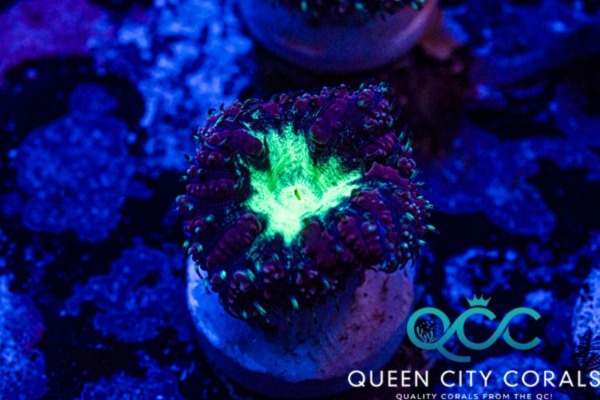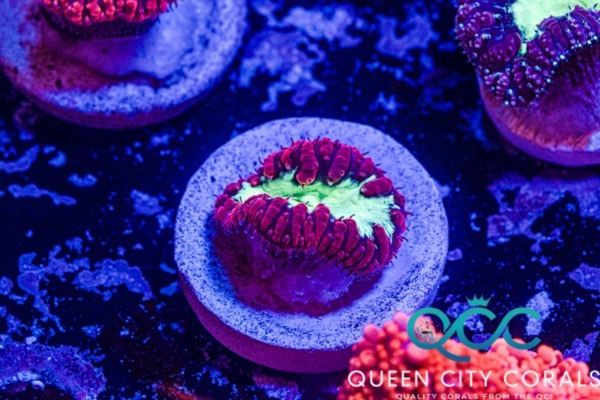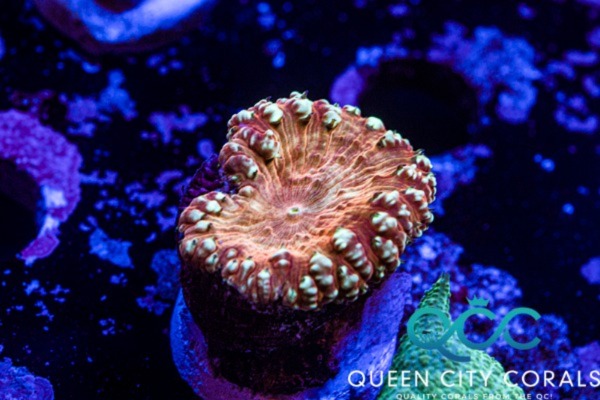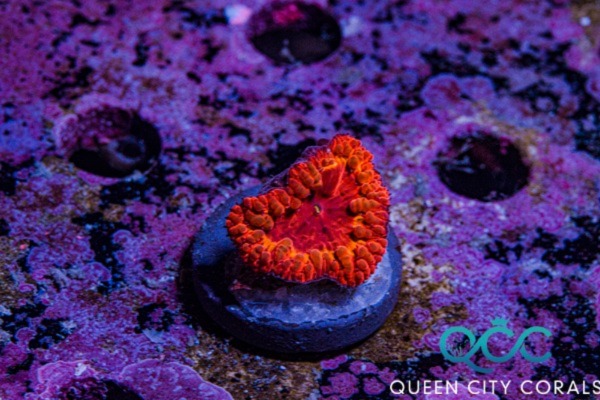Blastomussa Coral: Care, Appearance & Types, Fragging & More
Posted by on 01/29/2023
Fact checked by
We use affiliate links and may receive a small commission on purchases.
Blastomussa Corals, also known as "Blastos" are unique and eye-catching LPS (large polyp stony) corals that have caught the attention of both scientists and hobbyists since their discovery.
While there are only a handful of species in the genus, their uniquely shaped polyps and variety of colors make them an attractive option for reefers looking to add a new piece of coral to their collection.
In this post, we'll cover it all - we're going to discuss pricing, placement, and fragging. We'll even comment on some of our favorite types of Blastomussa corals that frequently go up for sale.
January's Giveaways on Light Fish
Species Summary
One of the most interesting parts of the Blastomussa genus of corals is that their ancestral family is still unknown. While there is some speculation that these corals are relatives of the Mussidae and Lobophyllidae families, their lineage remains shrouded in mystery.
Six species make up the genus, but two species in particular Blastomussa wellsi and Blastomussa marleti are the most common in the reef keeping hobby. These corals are native to the Indo-Pacific, where they've been designated a Near Threatened Status by the IUCN , making their conservation all the more important.

Size
Blastomussa Corals typically have polyps between 3-5 inches in diameter. Although they are slow growing, a small colony that consists of 6-7 heads can reach over a foot in width and will encrust over any rock as they grow.
When purchasing, it's fairly common to see these corals sold as a single polyp.
Growth Rate
Blastomussa Corals are slow growers, provided a stable aquarium with ideal conditions, it can take almost a year to see 2-4 new polyps form.
Although it's not required for these corals, spot feeding can increase growth rates as long as water chemistry remains optimal.
Appearance & Types
Healthy Blastomussa Corals should be plump and open, not receding showing their skeletal structure.
Similar to other species of corals, vendors often get creative with naming their Blastomussa corals. While there are a wide variety of common names, some Blastomussa Corals are more frequently seen than others.
Purple Blasto
The Purple Blasto is a commonly sold Blastomussa wellsi species known for its bright green center surrounded by dark purple ridges.
Arguably the most affordable Blasto species, a single polyp mounted to a ¾" frag plug tends to average between $15-30 USD.

Red Blasto
Similar to the Purple Blasto, the Red Blasto features a similar coloration, but instead of a dark purple ridge around the mouth of the polyp, the ridge of the Red Blasto has a brighter Fuschia coloration.
It's slightly rare compared to the Purple Blasto, but it's still affordable, at around $20-40 for a single polyp.

Golden Rain
Blues, pinks, and yellows tend to be the rarest colors seen in Blastomussa corals, so it comes as no surprise that this offering from North Carolina-based Queen City Corals is a bit pricier than some of their other offerings.
Shades of orange and blue are apparent in this variant, and a single polyp can run between $60-100 USD.

Iron Man
The Iron Man Blasto gets its name from the armor of the famous Marvel superhero . This Blastomussa wellsi showcases bright oranges and reds, making it a popular option for those looking to add some interesting color patterns to their coral collection.
You'll pay a premium price for this coral, a single polyp often sells for around $80-120 USD.

Blastomussa Coral Care
Caring for Blastomussa Corals is relatively straightforward. They are some of the easiest corals to keep, making them excellent options for those new to reef keeping. While some variants demand high price tags, some of the more common Blastos are relatively affordable, meaning you won't risk a big financial loss if things go south.
Still, as a responsible aquarist, it's your job to provide the best conditions possible for these invertebrates to grow and thrive.
Tank Size
We recommend an aquarium that's at least 50 gallons in size for keeping Blastomussa Corals.
While technically these corals will do fine in smaller tanks, nano-sized aquariums tend to be less stable, and are much more restrictive if you decide to add additional coral species and tank inhabitants in the future. Bigger is always better if your budget allows when it comes to tank size.
Water Parameters
Blasto corals are easy to keep. Most of the issues experienced by reef hobbyists are related to lighting. Stability is arguably the most important factor in reef keeping, and maintaining the following water conditions for your Blastomussa Coral should set you up for success.
Salinity: 1.023 - 1.025
dKH: 8-12
pH: 8.1-8.4
Nitrate: 2-5ppm
Phosphate: 0.02-0.05ppm
Calcium: 380-450ppm
Blastomussa corals are relatively tolerant to high nitrates and don't consume much calcium. If you can keep your water parameters within these ranges, you'll find success with keeping these species of coral.
Tank Setup
Planning your aquascape and deciding which inhabitants you plan on adding ahead of time is always beneficial. Invertebrates and fish often have particular requirements when it comes to territory, and the Blastomussa Coral is no different.
Placement
Blastomussa Corals should be placed out of direct flow, either on live rock or glued to a frag disk and placed on the sand bed.
Since these corals grow their own skeletons, they will eventually attach to whatever they're placed on. Gluing the frag to a ceramic disc gives you flexibility in moving the coral as it grows, but you can also place it on a frag rack until you decide on a more permanent home.
Just be sure not to place these corals next to aggressive coral species, such as torches, as they're defenseless when it comes to being attacked by sweeper tentacles.
Lighting
Blastomussa Corals prefer a shaded environment, with low to moderate lighting between 75-120 PAR. Recently purchased Blastos should be placed in the darkest section of a tank. After a few weeks have passed, you can transition the coral to an area with slightly more lighting.
Blastomussa wellsi species will tend to be a bit pickier when it comes to lighting, while Blastomussa merleti corals can adapt to higher light conditions. Always allow a few weeks to transition your corals to a higher light environment, otherwise, you may notice bleaching or the coral's tissue starting to recede.
Flow
Low to moderate flow is important when keeping Blastomussa corals. Aim for just enough flow so that detritus and fish waste don't accumulate on the flesh of the coral.
Blastomussa corals should be positioned out of the direct flow of a powerhead. Adjustable powerheads can make dialing in the right amount of flow a bit easier, but you can also place your Blastomussa behind live rock to avoid direct flow.
Feeding
Blastomussa corals, similar to leather corals and chalices share a symbiotic relationship with zooxanthellae. This relationship means you don't need to directly feed your Blastos, but they can still benefit from extra feeding.
Feeding your Blastomussa corals products such as Reef Roids once or twice a week will improve their development and growth rate.
You won't need to worry about overfeeding your Blastos, as they will expel any extra food that they consume.
Behavior
Blastomussa corals are a peaceful genus. They won't sting or attack any neighboring corals. Blastomussa corals can be placed next to other Blastomossa species, or other peaceful corals such as Acantherea.
When healthy, these corals should puff up, but for the most part, they're slowing-growing corals and don't display any active movement such as what you'll see with a species such as Pulsing Xenia.

Fragging
Blastomussa Corals aren't the easiest corals to frag. Certain Blasto species such as Merletti are a bit easier to frag than Wellsi, but you'll need a band saw to get the job done.
First, disinfect the coral by dipping it in a combined mixture of tank water and Lugols Iodine Solution .
Then, using the band saw, cut along the corallite wall, making sure to avoid cutting the tissue. After cutting, dip the coral in a restorative dip, such as Brightwell Aquatics Restor .
Last, you can glue the fragged coral to a plug, and place the coral on a frag rack before you move the coral to a permanent location in your display tank, or prepare the coral for shipment to another hobbyist.
Tank Mates
Since Blastomussa Corals will not attack neighboring corals, you can create unique Blasto gardens by grouping other Blastomussa species.
Other corals, such as Leather Corals and Chalices can be kept in an aquarium with Blastomussa corals, but you'll want to allow for quite a bit of space in between your Blastomussa Corals. Always consider the length of any neighboring corals' stinger tentacles when deciding on coral placement.
As far as livestock, you'll want to select fish that are suitable for your tank size. Some of our favorites include:
- Blue Chromis
- Pink Skunk Clownfish
- Snowflake Clownfish
- Blonde Naso Tang (you'll need at least 180-gallon tank for this species)
- Cleaner Shrimp
- Orange Spotted Goby
- Pink-Streaked Wrasse
Avoid large, aggressive fish such as the Tessalata Eel, as these can easily knock over your corals. You'll also want to avoid Copperbands and other Butterflyfish, as they will pick at and eat corals.
Conclusion
As you can see, Blastomussa Corals are excellent corals for both new and experienced reef hobbyists. Their appearance and care requirements make them an excellent option for an at-home reef aquarium, and you won't be disappointed with their captivating appearance.
Now that you've learned all about this genus of coral, do you plan on adding one to your reef tank? Let us know by commenting below, and check out our marketplace and community forum where you can discuss reef keeping with other hobbyists.
January's Giveaways on Light Fish


